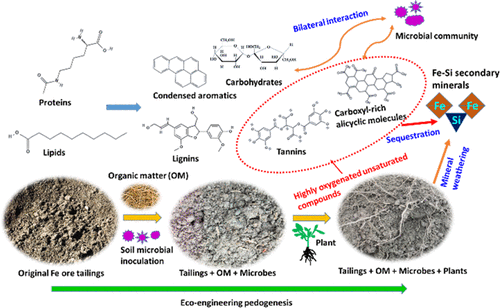当前位置:
X-MOL 学术
›
Environ. Sci. Technol.
›
论文详情
Our official English website, www.x-mol.net, welcomes your
feedback! (Note: you will need to create a separate account there.)
Chemodiversity of Dissolved Organic Matter and Its Molecular Changes Driven by Rhizosphere Activities in Fe Ore Tailings Undergoing Eco-Engineered Pedogenesis
Environmental Science & Technology ( IF 10.8 ) Pub Date : 2021-09-27 , DOI: 10.1021/acs.est.1c04527 Songlin Wu, Fang You, Berin Boughton, Yunjia Liu, Tuan A. H. Nguyen, Jeremy Wykes, Gordon Southam, Lachlan M. Robertson, Ting-Shan Chan, Ying-Rui Lu, Adrian Lutz, Dingyi Yu, Qing Yi, Narottam Saha, Longbin Huang
Environmental Science & Technology ( IF 10.8 ) Pub Date : 2021-09-27 , DOI: 10.1021/acs.est.1c04527 Songlin Wu, Fang You, Berin Boughton, Yunjia Liu, Tuan A. H. Nguyen, Jeremy Wykes, Gordon Southam, Lachlan M. Robertson, Ting-Shan Chan, Ying-Rui Lu, Adrian Lutz, Dingyi Yu, Qing Yi, Narottam Saha, Longbin Huang

|
Dissolved organic matter (DOM) plays an important role in soil structure and biogeochemical function development, which are fundamental for the eco-engineering of tailings-soil formation to underpin sustainable tailings rehabilitation. In the present study, we have characterized the DOM composition and its molecular changes in an alkaline Fe ore tailing primed with organic matter (OM) amendment and plant colonization. The results demonstrated that microbial OM decomposition dramatically increased DOM richness and average molecular weight, as well as its degree of unsaturation, aromaticity, and oxidation in the tailings. Plant colonization drove molecular shifts of DOM by depleting the unsaturated compounds with a high value of nominal oxidation state of carbon (NOSC), such as tannin-like and carboxyl-rich polycyclic-like compounds. This may be partially related to their sequestration by secondary Fe–Si minerals formed from rhizosphere-driven mineral weathering. Furthermore, the molecular shifts of DOM may have also resulted from plant-regulated microbial community changes, which further influenced DOM molecules through microbial–DOM interactions. These findings contribute to the understanding of DOM biogeochemistry and ecofunctionality in the tailings during early pedogenesis driven by OM input and pioneer plant/microbial colonization, providing an important basis for the development of strategies and technologies toward the eco-engineering of tailings-soil formation.
中文翻译:

进行生态工程成土的铁矿石尾矿中溶解有机物的化学多样性及其根际活动驱动的分子变化
溶解有机质(DOM)在土壤结构和生物地球化学功能发展中起着重要作用,是尾矿-土壤形成生态工程支持尾矿可持续修复的基础。在本研究中,我们表征了以有机质 (OM) 改良剂和植物定植为基础的碱性铁矿石尾矿中的 DOM 组成及其分子变化。结果表明,微生物 OM 分解显着增加了尾矿中 DOM 的丰富度和平均分子量,以及其不饱和度、芳香度和氧化度。植物定植通过消耗具有高标称碳氧化态 (NOSC) 值的不饱和化合物,例如类单宁和富含羧基的多环类化合物,来推动 DOM 的分子转移。这可能部分与它们被根际驱动的矿物风化形成的次生 Fe-Si 矿物隔离有关。此外,DOM 的分子变化也可能是由植物调节的微生物群落变化引起的,这通过微生物-DOM 相互作用进一步影响了 DOM 分子。这些发现有助于了解由 OM 输入和先驱植物/微生物定殖驱动的早期成土过程中尾矿中的 DOM 生物地球化学和生态功能,为制定尾矿-土壤形成生态工程的策略和技术提供重要基础。DOM 的分子变化也可能是由植物调节的微生物群落变化引起的,这通过微生物-DOM 相互作用进一步影响了 DOM 分子。这些发现有助于了解由 OM 输入和先驱植物/微生物定殖驱动的早期成土过程中尾矿中的 DOM 生物地球化学和生态功能,为制定尾矿-土壤形成生态工程的策略和技术提供重要基础。DOM 的分子变化也可能是由植物调节的微生物群落变化引起的,这通过微生物-DOM 相互作用进一步影响了 DOM 分子。这些发现有助于了解由 OM 输入和先驱植物/微生物定殖驱动的早期成土过程中尾矿中 DOM 的生物地球化学和生态功能,为制定尾矿-土壤形成生态工程的策略和技术提供重要基础。
更新日期:2021-10-06
中文翻译:

进行生态工程成土的铁矿石尾矿中溶解有机物的化学多样性及其根际活动驱动的分子变化
溶解有机质(DOM)在土壤结构和生物地球化学功能发展中起着重要作用,是尾矿-土壤形成生态工程支持尾矿可持续修复的基础。在本研究中,我们表征了以有机质 (OM) 改良剂和植物定植为基础的碱性铁矿石尾矿中的 DOM 组成及其分子变化。结果表明,微生物 OM 分解显着增加了尾矿中 DOM 的丰富度和平均分子量,以及其不饱和度、芳香度和氧化度。植物定植通过消耗具有高标称碳氧化态 (NOSC) 值的不饱和化合物,例如类单宁和富含羧基的多环类化合物,来推动 DOM 的分子转移。这可能部分与它们被根际驱动的矿物风化形成的次生 Fe-Si 矿物隔离有关。此外,DOM 的分子变化也可能是由植物调节的微生物群落变化引起的,这通过微生物-DOM 相互作用进一步影响了 DOM 分子。这些发现有助于了解由 OM 输入和先驱植物/微生物定殖驱动的早期成土过程中尾矿中的 DOM 生物地球化学和生态功能,为制定尾矿-土壤形成生态工程的策略和技术提供重要基础。DOM 的分子变化也可能是由植物调节的微生物群落变化引起的,这通过微生物-DOM 相互作用进一步影响了 DOM 分子。这些发现有助于了解由 OM 输入和先驱植物/微生物定殖驱动的早期成土过程中尾矿中的 DOM 生物地球化学和生态功能,为制定尾矿-土壤形成生态工程的策略和技术提供重要基础。DOM 的分子变化也可能是由植物调节的微生物群落变化引起的,这通过微生物-DOM 相互作用进一步影响了 DOM 分子。这些发现有助于了解由 OM 输入和先驱植物/微生物定殖驱动的早期成土过程中尾矿中 DOM 的生物地球化学和生态功能,为制定尾矿-土壤形成生态工程的策略和技术提供重要基础。









































 京公网安备 11010802027423号
京公网安备 11010802027423号